#Sims 3 San Simeon
Text

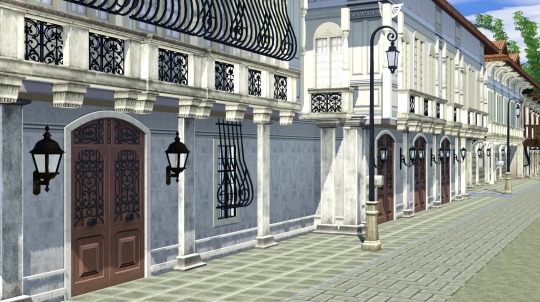
A preview of things to come.
21 notes
·
View notes
Text

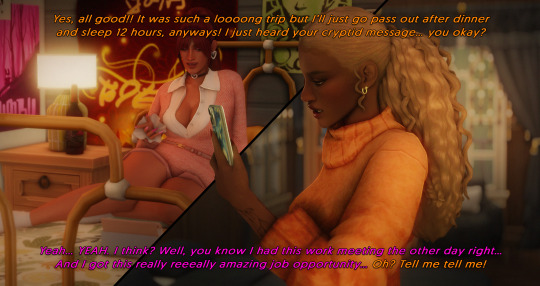




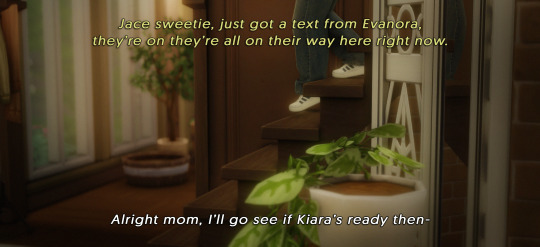
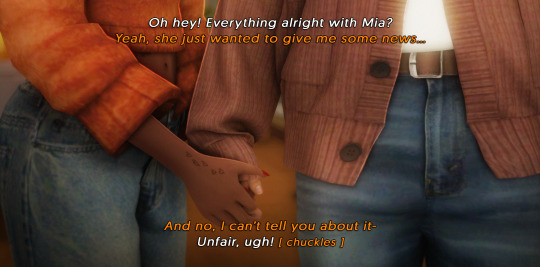




77. news and a welcome!
previous [.beginning.] next >
transcript under the cut
Kiara - Hi babe-
Mia - Hey bae! Did you arrive alright?
Kiara - Yes, all good!! It was such a loooong trip but I’ll just go pass out after dinner and sleep 12 hours, anyways! I just heard your cryptid message… you okay?
Mia - Yeah… YEAH. I think? Well, you know I had this work meeting the other day right… And I got this really reeeally amazing job opportunity…
Kiara - Oh? Tell me tell me!
Mia - It’s my dream job, babe. I’ll get to design clothes for a living, and that’s all I ever wanted really-
Kiara - Holy shit Mia!! Congrats!! Oh my god! YOU DID IT!!!!
Mia - Thanks bae…
Kiara - What 's the issue? Why don’t you seem happy?
Mia - Ah… Well… I would have to move to San Myshuno. I couldn’t do it from Strangerville anymore…
Kiara - Oh… I see…
Mia - Yeah…
Kiara - Babe, listen, we’re all gonna miss you around the house but, it’s not like we can’t visit each other, right? This is a once in a lifetime opportunity, do you really just wanna… throw that away?
Mia - No… I- I actually don’t, and that’s what’s making me feel like shit… I feel guilty about this almost-
Kiara - Please, don’t!! We should celebrate it, you, specially, should celebrate it.
Mia - God… I feel stupid… You’re so right!! Thanks babe! I’m going to call Ruru and go for drinks! Oh and don’t tell anyone about this yet, ‘kay?
Kiara - Your secret is safe with me, babe! Have fun with Ruru! Give her a kiss from me-
Mia - Love yaaaa!! Don’t do anything I wouldn’t do on that bed, alright?
Kiara - Stop!!! Byeee, love you too-
-
Raven - Jace sweetie, just got a text from Evanora, they’re on they’re all on their way here right now.
Jace - Alright mom, I’ll go see if Kiara’s ready then-
Jace - Oh hey! Everything alright with Mia?
Kiara - Yeah, she just wanted to give me some news... And no, I can’t tell you about it-
Jace - Unfair, ugh!
Kiara - [ chuckles ]
Kiara - Sorry for disappearing Mrs. and Mr. Silversweater, can I help with anything in the kitchen?
Raven - Thank you, but don’t worry sweetheart, just rest. Simeon and I got this!
-
Kiara - OMG, hi everyone!!
L.Faba - I can’t believe you’re real, actually!
Evanora - Faaaabaaa!!!
Kiara - I- Thanks?
Grace - We’re so happy that you could come-
Morgyn - KIARAAAAA!!!! My beloved! You must show me your dress for the wedding!!! Is it the blue one?
Kiara - Yes, with the butterflies-
Morgyn - Girl, I’ll come over and we’ll get ready together!
Simeon - I heard screaming…?
Jace - Don’t worry Simeon, just Morgyn being Morgyn-
Raven - I think you just lost your date, sweetie.
#HELLO NEW ARC <33 we're aproaching the posts i firstly imagined in my mind after 3 years so im excited#contagiouschemistry#mp#ts4 story#ts4#the sims 4#sims 4 story#simblr#glimmerbrook#san myshuno#kiara gold#mia santina caliente#jace thrasher#raven silversweater#simeon silversweater#evanora cordova#grace anansi by marigold#l.faba#tomax collette#cassandra goth#morgyn ember
130 notes
·
View notes
Photo
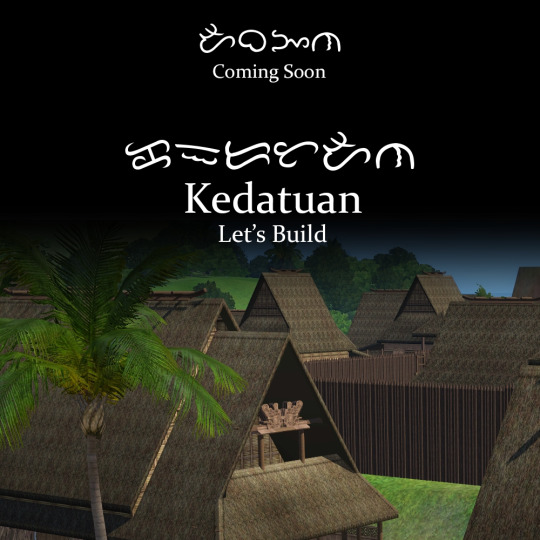




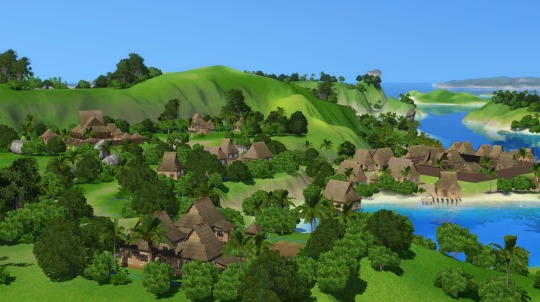


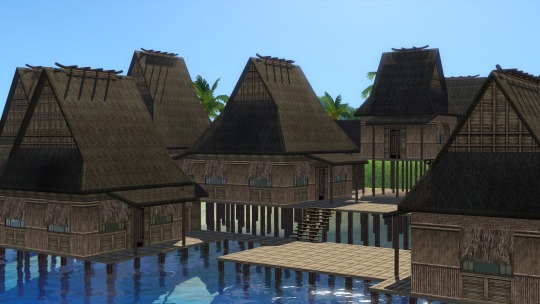

Welcome, my friends, to the Kedatuan
Kedatuan is San Simeon before the dawn of the colonial era. I’ve gotten as far as a complete map that’s partially built over. However, having others to help me out will make the project easier to finish. Thus, I decided to open up a Let’s Build invite and make this a community project to interested Sims 3 simmers.
The project formally opens on Republic Day, 4 July. By then, I would’ve finished the map and have everything set up. I will be hosting the build’s discussions on a dedicated server on Discord.
It is open to all interested Sims 3 simmers on ModTheSims, Tumblr, and Discord. If you want to join in, drop me a line and I’ll have an invitation on or before the 4th of July. Learn more about the project here. Expect further details on the project will be available on opening day.
38 notes
·
View notes
Text
Seeds of Deception, Harvests of Renewal

Pumpkin doesn't like toilets, ovens, or stereos, but she does like TVs
I'm not sure how far along Ruby's lifetime wish was in The Sims 3, but I decided to try to get some kind of a head start on it, just to see how it would go. I've formatted a basic plan: have Ruby become partners with Sims that are already married, get the spouses to catch the adultery, have Ruby tell the Sim she's cheating with to break up with their spouse, and then break up with them after that.
I haven't had the opportunity to test this out, but with the Romance Festival in San Myshuno, Ruby was able to meet a few Sims that fit the bill.
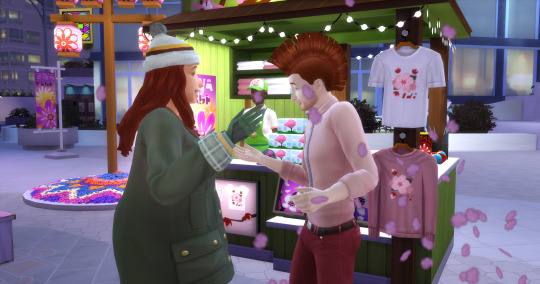

In this same festival, Flat and Flo renewed their vows, which was incredibly sweet to watch
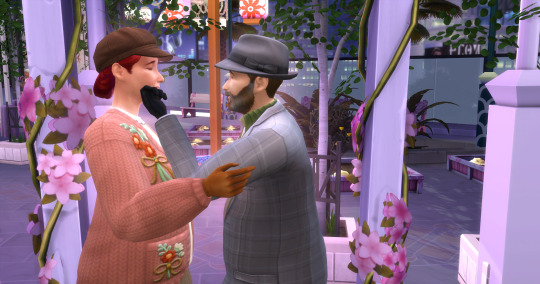





After the festival, Ruby went to the club and ended up getting into a dance battle with Simeon Silversweater, who clearly didn't understand that Ruby maxed out her dancing skill a while ago



While she was there, I discovered that Joaquin Le Chien had died. This didn't seem to bother him, as he tried (successfully) to flirt with Ruby.


By the time she came home, it was literally six in the morning, and the only thing that kept her from crashing on the dance floor was a nap on a couch upstairs. She still ended up sleeping the entire day, waking up around 8pm, but then was still tired, and slept through another night.
While Ruby was recovering her sleep and getting back to normal again, the lot was pretty quiet. It was just Flat, Flo, and Skip spending time together, which was pretty nice.



Since the Romance Festival, Flat and Flo have been even more flirty than they were before, causing Flat to literally serenade her upon coming home from work. She found it extremely alluring.
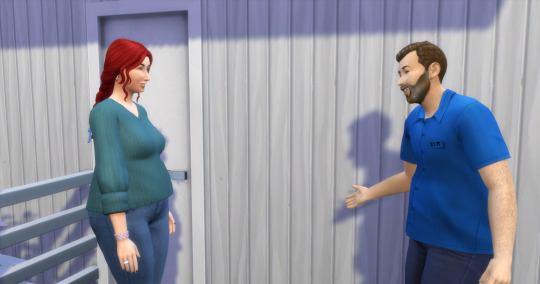
#not sure if the title is obnoxious or heavy handed but i don't feel like redoing it#the sims 4#ts4#simblr#the sims 4 gameplay#the sims 4 screenshots#the sims 4 legacy#sims 4#ts4 gameplay#the brokes#images have alt text
2 notes
·
View notes
Photo
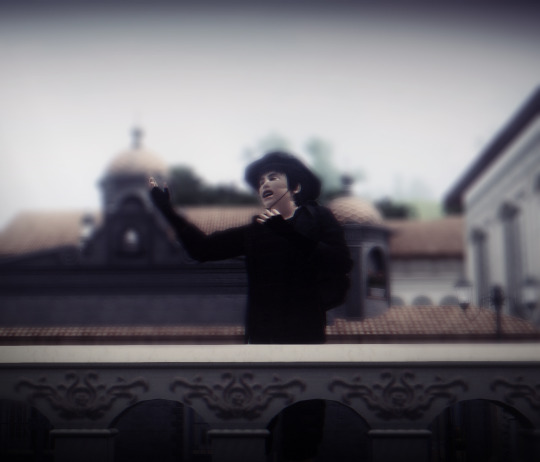

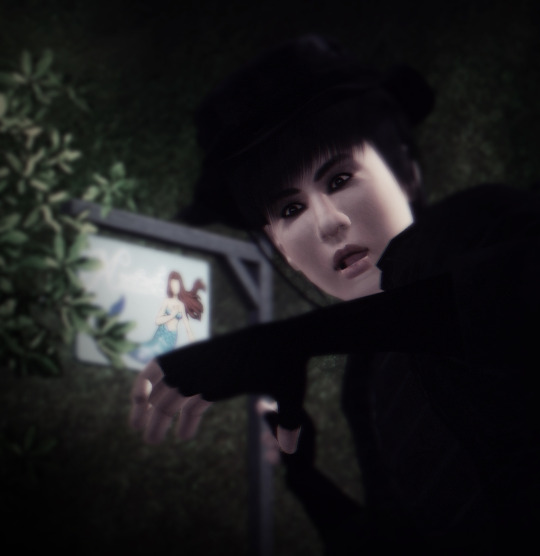
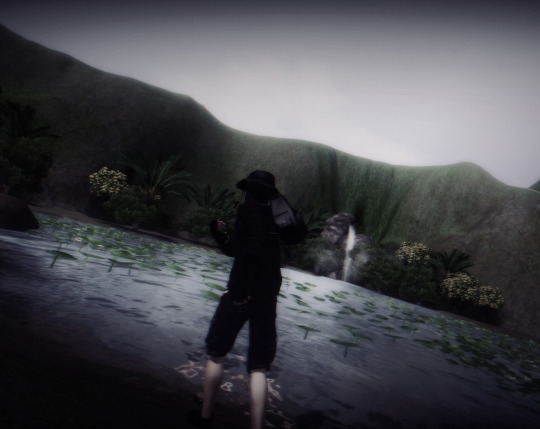

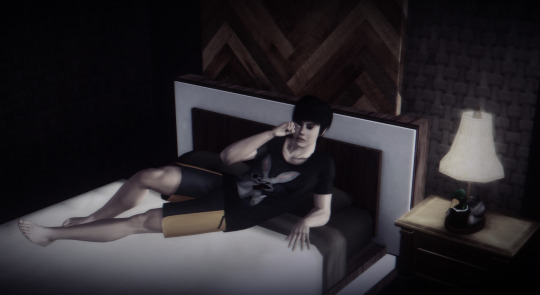

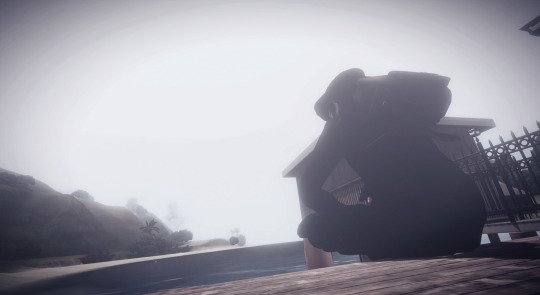

18 Years Old Ridwan Chandra (Part2)
OST: Good Charlotte - Predictable
Sebelum berangkat ke Filipina, Ridwan sempat diomelin oleh mamanya, mengenai style pakaiannya yang berubah semenjak masuk kuliah. Yang dipakai baju hitam terus. Sedangkan pakaian warna normal lainnya, yang dibeli mamanya, tidak terpakai sama sekali. Ditambah ceramah lainnya kenapa sampai pakai eyeliner segala sebelum berangkat kuliah dan pulang kuliah. Kayak cewek aja.
Enci-nya, Tiffany, membela Ridwan, “Dia mau jadi anak band, Ma. Biar dilirik cewek-cewek kampus. Makanya dia bergaya kayak gitu. Lagian, pensil eyeliner dia beli sendiri. Gak nyolong punya Mama, kan?”
Papanya juga membela Ridwan, “Biarlah Ridwan mau bergaya apa, toh suka-suka dia. Namanya juga anak muda. Yang penting gak ngerokok, tatoan, narkobaan.” Lanjutnya, “Nanti berapa tahun lagi juga balik normal kayak laki lainnya.”
Mengenai tur solo ke Filipina, Papanya mendukung Ridwan berangkat sendiri, tak usah ditemani. Tiket dan urusan perjalanan biarlah Ridwan semua yang mengurus sendiri. Anak laki harus mandiri dan bisa mengurus diri sendiri, kata Papanya.
------------------------------------------------------------------------
Credits:
Boonie Bucket Hat by @ infisim
Backpack by @aroundthesims
Clothing (mesh by @darte77 converted to TS3 by @simsoficeandfire)
Download San Simeon link post
#ts3#the sims 3#ts3 screenshots#The Sims 3 Screenshots#ts3 emo#ts3 male sim#the sims 3 male sim#male sim#ridwan chandra#ts3 beach#ts3 asian#the sims 3 asian#ts3 southeast asian#ts3 phillipines#San Simeon#2008#ts3 indonesian#indonesian#ts3 edit#sansimeonsims#ts3 goth#the sims 3 goth#the sims indonesia#emo
21 notes
·
View notes
Text
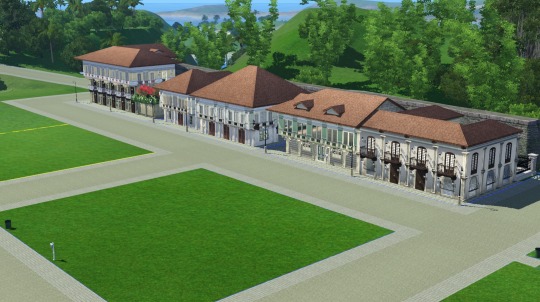

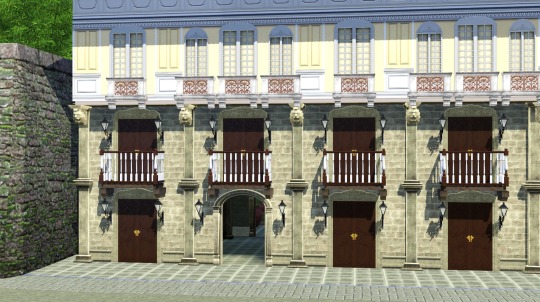
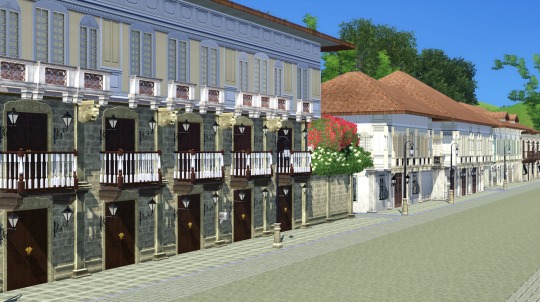
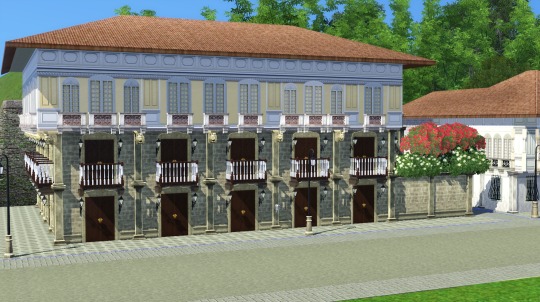
Muralla Street and Casa de Leon Oro
Muralla Street takes its name from the similarly named street in Manila's Old City and takes visual cues from the structures built in Plaza San Luis on Luna street in the same district (fittingly, i was just there last Holy Week) as well as some of the ancestral houses in the historic district in the town of Taal in Batangas Province. It gets its name from the fact that it's literally the road near the wall.
The house I'm featuring first is the third house I built (yes, this monstrosity is a residential), the Casa de Leon Oro, so named for both its owners (the parvenu Principalia De Leon family, who despite their rank, actually began as a peasant family) and for the lion corbels they had placed on top of the masonry second story of their house. The family itself lives in the luxurious top floor, while the second and first floors are used as offices, rented to tenants, or occupied by servants and horses.
This house was based heavily on the Casa Manila Museum in the Old City (the reconstructed Mendoza house, originally from the district of San Nicolas). I originally made a similar multi-building lot called Parian de San Simeon, made around the time I could only fit a few buildings in a world at a time. You can see the similarities and contrasts by checking out the original posts.
17 notes
·
View notes
Text
An Announcement
Magandang araw po, mga kaibigan.
These past few months, I haven't done a lot of updates to San Simeon and my other Filipino-themed worlds. I've been going through a few things in real life and current events aren't helping at all. Thus, I had to focus on my mental health and professional commitments. What little time I had for simming, I reserved for low commitment projects like the Praaven Cathedral.
To put it in the most delicate possible words, shit happened. And the build up to it sucked the joy out of many of my projects. Our current social climate isn't exactly friendly to faithful depictions of history. This goes double for contemporary history past the Second World War. And this atmosphere is likely to get even more hostile moving forward.
What Now?
While these events have made it rather stressful to make my content, it didn't dent my love for it. I would like nothing more than to share my country's history and culture with others. I am honored to share my work to both to my fellow Filipinos and to the international Sims 3 community. The work and goodwill I've earned from making San Simeon and its sister projects makes it all worth it.
I've already made 2 commitments that I plan to see through to the end. One is the a remade San Simeon and the other is a precolonial version set before Spanish rule. Although I couldn't muster the mental energy to work on them, I can commit to at least finish them for everyone’s sake.
What I cannot promise is if I can continue my other world building project, Camayao. This is set in a more contemporaneous Philippines and had elements of social satire. At present, I live in a cultural zeitgeist where I could get a lot of grief for doing so. And that is putting it lightly.
This, coupled with the difficulty involved in its creation, makes Camayao a tall order on its own. Events in the past few months was the final nail in the coffin for this project and others like it. I will not make any more contemporary Filipino-themed builds in the Sims 3 set in a time past 1945.
What Next?
That said, I've already done a lot of the individual buildings. It would be a crying shame to see them languish in some folder. Maybe they can find a good home with someone else.
What am I to do with the content already created?
Some will be released as individual lot files, depending on their level of completion.
Others will be released alongside San Simeon to fill in some of the newer lots I've added to the much larger world. This has the added benefit of making that other project less of a pain to finish.
If nothing else, my past efforts will hopefully not be consigned to obscurity.
Will I ever come back to Camayao as a full world building project? I can't say. Maybe someday, but then again maybe not. I’ve a lot on my plate personality-wise. I also have other things that interest me that won’t give me as much grief. After I finish, I will resume work on the Roman world and a few others I've had planned.
Would I allow someone else to pick up where I left off? I'm not sure, but I am open to the idea. Feel free to contact me if you’re interested in adopting it yourself. As for my other, still active projects, that is a subject for another day.
On the Matter of Facebook
My projects first became truly popular on Facebook, where I enjoyed a brief moment of Internet fame as “the guy who made a Filipino-themed Sims 3 world.” Since then, I’ve created a page to have the Facebook people see some of my newer builds and appreciate Filipino history and culture.
In the past few months, however, I found it better for my mental health to ignore Facebook. Indeed, I find interacting on that site a mentally taxing chore. As pleasant as my success there was, I am not overly attached to my following there at all. In any case, the majority of any meaningful engagement I’ve had had been on Tumblr anyway. However, since part of my real-world jobs involve managing a Facebook page, I cannot disengage completely, even if I can ignore it for health purposes.
In the interest of my followers there, I will set things up so that they get alerted for my Tumblr uploads moving forward. I should have it done in a few days after this is published.
Closing Thoughts
I’d like to thank you all for being part of this journey of discovery with me. What began as a simple set of builds for a Filipino-themed legacy challenge eventually became an obsession that lasted nearly a decade. I enjoyed learning new things about my country’s history, and it felt nice knowing that it had an impact on not just myself but the Sims 3 community and my fellow Filipinos who stumbled upon it. The appreciation you all gave certainly helped keep me going.
We live in a time where knowing the truth of our past is in jeopardy. As the old Tagalog proverb goes, whoever can’t look back can never truly move forward. I’d like to close this statement with a line from Doc J. himself:
“But the generation that deciphers these characters will be an intelligent generation, it will understand and say, ‘Not all were asleep in the night of our ancestors!’“
10 notes
·
View notes
Photo



Thanks to @grandelama‘s conversion of HolySimoly’s Old Mason architecture set, I finally have squarish half-columns that look exactly like the kind of architectural detail I would find in the masonry floors of old colonial-era buildings. And with this around, I can finally capture the appearance of some of those street scenes.
I’m still kind of looking for textures that match the preset in the conversions (alternately, I could try to remove it) but that’s an easier hurdle to overcome, especially given how object-intensive my colonial builds tend to be.
30 notes
·
View notes
Text
Bibliography and Visual References
When I began creating San Simeon, I wanted a setting where I could play out a legacy challenge themed to Filipino history. I've always wanted to try a historical legacy challenge and this was the story I was most confident in telling. And while it would be a lot of work, at least I was working from a place of familiarity. Or so I thought. Turns out I had a lot to learn.
I did a lot of research on colonial (and later, precolonial) history to get the aesthetic right. Illustrated works were crucial since the Sims 3 is a visual medium that favored a lot of detail. I also needed to know how societies of the time worked so I could adapt them into game play. I can’t put in everything, of course, but I try to adapt as best I can.
Here’s a general list of the sources I used to recreate my historical builds and settings, plus a few works that I’d recommend for those interested in Philippine history. Note that I have a strong preference for visual works.
Period Documents
Laguna Copperplate Inscription (900): The earliest surviving written document found in the Philippines whose incidental details provide a look into the lives of the aristocracy of the period. The English translation can be found here.
Relazione del primo viaggio intorno al mondo (c. 1524 - 1525) by Antonio Pigafetta. Known in English as The First Voyage Round the World, this was the first published account of European contact between Europeans and the people of what would become the Philippines. Prior to the Copperplate Inscription’s discover this and similar accounts from later Spanish chroniclers were the primary sources of what Filipino people were like before the conquest. You can read Lord Stanley’s translation on Wikisource or Robertson’s translation on Project Gutenberg.
Boxer Codex (c. 1590): A Spanish illustrated book showing the appearance and clothing worn by the inhabitants of East and Southeast Asia during the late 16th Century, with a focus on the indigenous inhabitants of the Philippines. Images can be viewed from the Indiana University Digital Library or Wikipedia.
Sucesos de las Islas Filipinas (1603) by Antonio de Morga. This was an official chronicle of the country from the early 17th Century, providing official accounts of both prominent conquerors and indigenous leaders and provides a glimpse of life during the early days of the conquest. This book was important in Dr. Jose Rizal’s own analysis of Philippine history and he annotated his own copy extensively. The English edition is available from Archive.org.
Bankoku Sozu (c. 1671): This name refers to a type of world map first published in Japan during the Tokugawa shoguns came to power. These maps, while stylistically Japanese, used techniques learned from European scholars. The maps also included a collection of images representing the national costumes of people from the countries of the world. A few of these maps depict colonial-era indigenous Filipinos. Notably, the man is wearing stockings, indicating the couple depicted came from the native nobility (principalia), who were likely to imitate the fashions of the colonizers. See two examples from the University of British Columbia and Wikipedia.
Carta Hydrographica y Chorographica de la Yslas Filipinas Manila (1734): The period map contains illustrations of daily life in the Philippines during the 18th century, including depictions of what the people of the time, from the natives and foreign traders to the Spanish and Mestizo elite, had been wearing during that
Catalogo alfabetico de apellidos (1849), by the administration of Governor General Narciso Claveria y Zaldua: This is a compilation of period surnames from 1849, assigned to various indigenous Filipino families who lived in the Spanish-controlled areas of the country.
Period and Period-Inspired Art
Huang Qing Zhigong Tu (c. 1761), by Xie Sui: Also known as Paintings of Tributary People of the Great Qing, this is an ethnographic compendium of tributary peoples of Qing Dynasty China, which includes depictions of people within the Chinese Empire, its neighbors that pay it tribute (hence, “tributary”), and foreign nations in Europe. The book depicts two regions now found in the Modern Philippines. The first are a man and woman from the Sulu Archipelago, which had at the time been a separate nation in constant conflict with the Spanish. The second a depiction of a man and a woman from what is identified as Luzon. While the woman wears clothing that can be clearly identified with the native aristocracy, the man wore European clothes, indicating that he is a European colonizer (and confirmed within the text).
The full illustration is shown on this link from the National Palace Museum in Taiwan. This article, meanwhile, shows important highlights of the document and provides commentary on it in English (and singles out the pair of Filipinos). You can also download the full text and images as a .pdf for free here (the link to buy is for a hardbound copy).
The illustrations of the artists of the Malaspina Expedition (c.1792): These images depict Manila and various parts of the Philippines from before the 19th century. As most images of the Philippines in the popular consciousness are based on mid- to late 19th Century images, these prints are a valuable source of information on 18th and Early 19th Century Philippine architecture from the British occupation to the time of Napoleon’s conquest of Europe.
Tipos de País (folk costume) paintings by Damian Domingo and others (1820s onward): There are many of them. I frequently find them in many of my sources. They’re a useful reference in creating depictions of 18th through 19th Century clothing in the Sims. You can see a sizable collection of them on Wikipedia.
The works of Fernando Amorsolo (1914 - 1972): Amorsolo is among the most beloved artisans in living memory and his oil paintings provided a glimpse of what turn of the 20th Century Filipino life was like. His portrayals are quite idealized and romanticized, however, which means you have to take their depictions of happy peasants in bucolic environments with a grain of salt.
The Visual Noli me Tangere by Leonardo Tayao Cruz (2002 - 2006): These are a series of paintings patterned after the chapters of Rizal’s seminal novel. Each painting is a depiction of the Philippines in the mid-1800s. You can view the paintings here.
Photographs and Image Compilations
The Manila Daguerreotypes (c. 1840s): These are the oldest photographs taken of what would become the modern Philippines and show Manila as it was in the 1840s. These were taken by an anonymous photographer who was a guest at an American trading house somewhere in Manila. View these photos at Filipiknow.net.
Various photographs and prints from the collections of John Tewell: If you want a one-stop shop for various period images, look no further. Included are various images of Manila during the turn of the century and copies of the urban cityscapes of the Malaspina Expedition.
Reputable Web and Social Media Sources
The Time Trekker: The Time Trekker is a Facebook page run by one of my old professors in college, Mr. J.P Abellera (notably, he was also involved in the production of Quezon's Game). Included are photographs he and other like-minded history lovers took of heritage structures across the country.
Project Vinta: An official page of the Ramon Magsaysay Foundation, the page shares various events and facts on the history of the Philippines. It has a series called "On This Day" where it shares the stories behind major events that took place on a specific date in Philippine history.
The National Quincentennial Committee: This government-sponsored organization is responsible for the 500th anniversary of Spanish contact and the events surrounding it, including the Battle of Mactan. The committee also provides plenty of resources on precolonial Filipino societies on the eve of contact.
Renacimiento Manila: Renacimiento Manila focuses on heritage preservation within Manila itself and is involved in a digitized scale reconstruction of the heritage structures both extant, reconstructed, and lost to recreate Manila as it may have appeared on the eve of the Second World War. The page and the organization behind it also advocate for the in situ preservation of heritage structures. They also provide easy to understand resources on architectural styles and historical fashion, albeit restricted to Manila.
The National Museum of the Philippines: Physically, the National Museum is free to enter. The institution provides several exhibits on various aspects of Philippine history and culture from the earliest part of human prehistory to the colonial era. Its exhibits also encompass natural history and ecology, so you can get to know what life was like before the first modern humans arrived in the Philippines. Their Facebook page is a good place to learn about various items (from fossils to historical artifacts) in their collection from home.
The Aswang Project: This website and its associated YouTube channel is an excellent beginner’s resource on the mythologies (note the plural) of the Philippines, which includes not only the stories associated with indigenous religions but also mythical creatures in pre- and post-colonial Philippine lore.
Period Literary Fiction
Noli me Tangere (1887) and El Filibusterismo (1891) by Dr. Jose P. Rizal: It just wouldn't be right not to include these two novels. Many Filipino literature nerds fell in love with the novel in high school. It was required reading for a good reason, too, as it illustrated the contemporaneous challenges faced by the native and mixed-race Filipinos during the terminal end of Spanish rule. I’ve linked to digital copies of the English translations, which are available for free on Project Gutenberg. I have the comic.
Reference Works
The Philippine Islands: 1493 - 1898 (1906), by various authors, edited by Emma Helen Blair and translated by James Alexander Robertson: This is a compendium of various documents related to the history of the Philippines translated into English. The books as compiled come in various volumes, some of which can be read from Project Gutenberg.
Filipinos in China Before 1500 (1989) by William Henry Scott. This annotated document provides a glimpse into the complex history of imperial China’s relations with the various states in the Philippines before Spanish contact. This provides a good historical snapshot of the Philippines at the time as it provides attestation for various states in the Pasig River Delta, Butuan, Pangasinan, and the Visayas. It can be read from the University of the Philippines - Dilliman website.
Looking for the Prehispanic Filipino (1992) by William Henry Scott. This is a collection of essays by Scott, which touches on the details of precolonial life and the ways that the historical records during the early contact period can be re-examined to paint a more accurate picture of life before and during the advent of the Spanish conquest. A copy can be found on Archive.org.
Kasaysayan: The Story of the Filipino People (1998), edited by Jose Y. Dalisay, Jr.: This is an encyclopedic compendium consisting of works written by various authors on different socio-political events in the Philippines from ancient prehistory to the 1986 People Power Revolution that ended the Marcos regime. The articles were written in-depth and provide insight and opinion into how precolonial, colonial, and post-colonial society worked at the time.
Fun fact: Many of the aforementioned illustrations can be found in these books’ pages.
Museum Exhibits
Various exhibits at Bahay Tsinoy: The heritage center’s many exhibits showcase the history of the Chinese settlers in the Philippines and the impact that Chinese Filipinos had in shaping the country’s culture, language, and political history.
Various exhibits at the Ayala Museum:
Gold of the Ancestors: This is an interactive exhibit showcasing the many gold grave artifacts (most of them grave goods) of the pre-Hispanic native aristocracy. The gold displayed the artisanship of the precolonial goldsmiths and the wealth of the lowland city-states of the period.
A Millennium of Contact: This exhibit provides excellent historical background for the contact that Ancient Filipinos had with the Chinese, as told through the ancient Filipino aristocracy’s favorite luxury import: fine porcelain.
Art and the Order of Nature in Indigenous Filipino Textiles: This exhibit provided a basic idea of how indigenous textiles worked. This is vital to creating and improvising the art and textiles of the pre-colonial inhabitants.
The Diorama Experience: Perhaps one of my biggest sources, rivaling Kasaysayan. These images provide a realistic depiction of many of the major milestones of Philippine history.
Remember: It's important to rely on multiple sources of good repute, so that you can compare details, spot possible errors, and make a fair assessment. As my research continues, expect the bibliography to expand.
42 notes
·
View notes
Photo




What started as an attempt to create photo-op areas turned into the premature re-edit of San Simeon. Here are a few preview pics. A few of these may become downloadable lots in the future so you wouldn’t need to update it whole hog again.
25 notes
·
View notes
Photo




A lighthouse (farola) in San Andres leads sailing ships and trade vessels to the safe harbor of San Simeon.
The lighthouse and its attendant keeper’s house and stable are based on the Malabrigo Lighthouse in Batangas, the Cape Melville Lighthouse in Ilocos Sur, and the now-lost old Corregidor Island Lighthouse in Bataan.
#Lighthouse#Sims 3 San Simeon#Sims 3 historical#Spanish Architecture in the Philippines#Philippine Colonial Architecture
17 notes
·
View notes
Photo



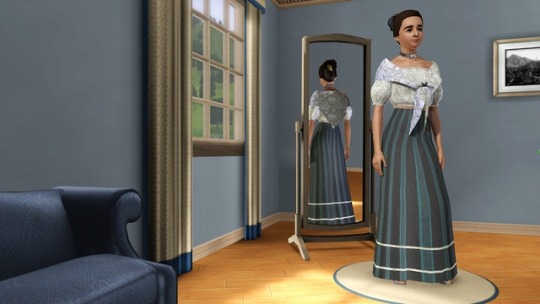

The Principalia represented the native Filipino elite and were descended from the aristocracy that dominated the lowland tribes and city-states from before the colonial period. They frequently served petty government positions, addressed day-to-day issues, were exempt from tribute and taxation, and owned land. They were usually the only ones who could vote when electing town officials.
One usually had to be born to the position, although by a longshot someone could be appointed into this class if one was educated enough to know some Spanish (which usually required one to be wealthy in the first place). Frequently, they and the Spanish elite intermarried as a form of mutual social mobility.
11 notes
·
View notes
Photo
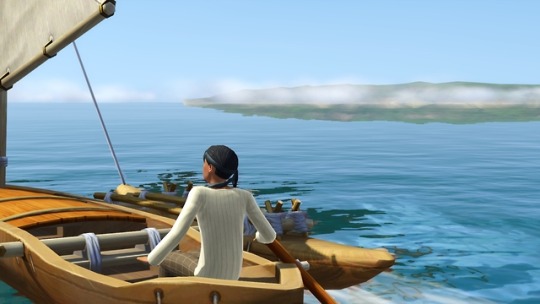

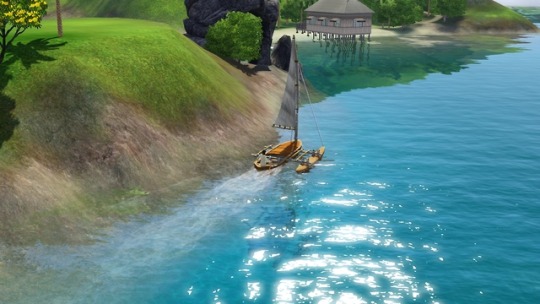

I’ve decided to give this fisherman his own sweet ride, care of @aroundthesims‘ conversion of a south pacific ship, which seemed thematically appropriate for this world. It struck me as more precolonial, though, so I may reserve it for more ancient playthroughs.
14 notes
·
View notes
Photo

A little reminder to y’alls that I finally have a working video card. The Sims 3 is currently the most stable game I can play, so good news to my followers.
Anyway, here’s a vagrant.
7 notes
·
View notes
Photo


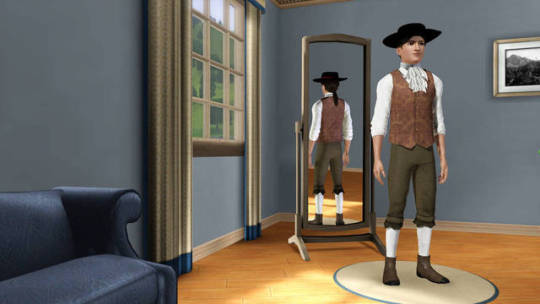


In contrast to the European elite, the Insulares (the creole population of the Philippines) enjoyed far fewer social privileges and rarely held any higher positions. This became a matter of policy to the Spanish government, which believed that Spaniards born in the homelands were more likely to be loyal to the interests of the crown.
The Insulares and their mestizo cousins and descendants would eventually merge with the local aristocracy and the suddenly wealthy sangleys to form the Filipino upper classes. Today, Mixed race Filipinos make up one of the largest minorities in the country.
9 notes
·
View notes
Photo
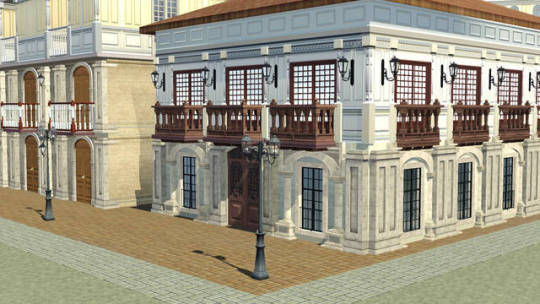



Scenes from the urban part of San Simeon. I gave this city block a facelift to better resemble the houses on General Luna Street in Manila’s Old City.
#Sims 3 San Simeon#Sims 3 historical#spanish colonial architecture#Spanish Architecture in the Philippines#philippine colonial architecture
9 notes
·
View notes